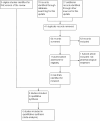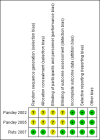Pharmacological treatment for pain in Guillain-Barré syndrome
- PMID: 25855461
- PMCID: PMC6361619
- DOI: 10.1002/14651858.CD009950.pub3
Pharmacological treatment for pain in Guillain-Barré syndrome
Abstract
Background: Pain in Guillain-Barré syndrome (GBS) is common, yet it is often under recognised and poorly managed. In recent years, a variety of pharmacological treatment options have been investigated in clinical trials for people with GBS-associated pain. This is an updated version of the original Cochrane review published in Issue 10, 2013.
Objectives: To assess the efficacy and safety of pharmacological treatments for various pain symptoms associated with GBS, during both the acute and convalescent (three months or more after onset) phases of GBS.
Search methods: On 3 November 2014, we searched the Cochrane Neuromuscular Disease Group Specialized Register, CENTRAL, MEDLINE and EMBASE. In addition, we searched ClinicalTrials.gov and the World Health Organization (WHO) International Clinical Trials Registry Platform.
Selection criteria: We included randomised controlled trials (RCTs) and quasi-RCTs in participants with confirmed GBS, with pain assessment as either the primary or secondary outcome. For cross-over trials, an adequate washout period between phases was required for inclusion.
Data collection and analysis: Two review authors independently screened the titles and abstracts of identified records, selected studies for inclusion, extracted eligible data, cross-checked the data for accuracy and assessed the risk of bias of each study.
Main results: Three short-term RCTs, which enrolled 277 randomised participants with acute phase GBS, were included. Risk of bias in the included studies was generally unclear due to insufficient information. None of the included studies reported the primary outcome selected for this review, which was number of patients with self reported pain relief of 50% or greater. One small study investigated seven-day regimens of gabapentin versus placebo. Pain was rated on a scale from 0 (no pain) to 10 (maximum pain). Amongst the 18 participants, significantly lower mean pain scores were found at the endpoint (day 7) in the gabapentin phase compared to the endpoint of the placebo phase (mean difference -3.61, 95% CI -4.12 to -3.10) (very low quality evidence). For adverse events, no significant differences were found in the incidence of nausea (risk ratio (RR) 0.50, 95% CI 0.05 to 5.04) or constipation (RR 0.14, 95% CI 0.01 to 2.54). A second study enrolling 36 participants compared gabapentin, carbamazepine and placebo, all administered over seven days. Participants in the gabapentin group had significantly lower median pain scores on all treatment days in comparison to the placebo and carbamazepine groups (P < 0.05). There were no statistically significant differences in the median pain scores between the carbamazepine and placebo groups from day 1 to day 3, but from day 4 until the end of the study significantly lower median pain scores were noted in the carbamazepine group (P < 0.05) (very low quality evidence). There were no adverse effects of gabapentin or carbamazepine reported, other than sedation. One large RCT (223 participants, all also treated with intravenous immunoglobulin), compared a five-day course of methylprednisolone with placebo and found no statistically significant differences in number of participants developing pain (RR 0.89, 95% CI 0.68 to 1.16), number of participants with decreased pain (RR 0.95, 95% CI 0.63 to 1.42) or number of participants with increased pain (RR 0.85, 95% CI 0.52 to 1.41) (low quality evidence). The study did not report whether there were any adverse events.
Authors' conclusions: Since the last version of this review we found no new studies. While management of pain in GBS is essential and pharmacotherapy is widely accepted as being an important component of treatment, this review does not provide sufficient evidence to support the use of any pharmacological intervention in people with pain in GBS. Although reductions in pain severity were found when comparing gabapentin and carbamazepine with placebo, the evidence was limited and its quality very low. Larger, well-designed RCTs are required to further investigate the efficacy and safety of potential interventions for patients with pain in GBS. Additionally, interventions for pain in the convalescent phase of GBS should be investigated.
Conflict of interest statement
EM has consulted for Javelin Pharmaceuticals, Wyeth and Ortho‐McNeil‐Janssen Pharmaceuticals.
JL and LNW: none known.
Figures
Update of
-
Pharmacological treatment for pain in Guillain-Barré syndrome.Cochrane Database Syst Rev. 2013 Oct 20;(10):CD009950. doi: 10.1002/14651858.CD009950.pub2. Cochrane Database Syst Rev. 2013. Update in: Cochrane Database Syst Rev. 2015 Apr 09;(4):CD009950. doi: 10.1002/14651858.CD009950.pub3. PMID: 24142399 Updated.
Similar articles
-
Pharmacological treatment for pain in Guillain-Barré syndrome.Cochrane Database Syst Rev. 2013 Oct 20;(10):CD009950. doi: 10.1002/14651858.CD009950.pub2. Cochrane Database Syst Rev. 2013. Update in: Cochrane Database Syst Rev. 2015 Apr 09;(4):CD009950. doi: 10.1002/14651858.CD009950.pub3. PMID: 24142399 Updated.
-
Antidepressants for chronic non-cancer pain in children and adolescents.Cochrane Database Syst Rev. 2017 Aug 5;8(8):CD012535. doi: 10.1002/14651858.CD012535.pub2. Cochrane Database Syst Rev. 2017. PMID: 28779487 Free PMC article.
-
Antiepileptic drugs for chronic non-cancer pain in children and adolescents.Cochrane Database Syst Rev. 2017 Aug 5;8(8):CD012536. doi: 10.1002/14651858.CD012536.pub2. Cochrane Database Syst Rev. 2017. PMID: 28779491 Free PMC article.
-
Systemic pharmacological treatments for chronic plaque psoriasis: a network meta-analysis.Cochrane Database Syst Rev. 2021 Apr 19;4(4):CD011535. doi: 10.1002/14651858.CD011535.pub4. Cochrane Database Syst Rev. 2021. Update in: Cochrane Database Syst Rev. 2022 May 23;5:CD011535. doi: 10.1002/14651858.CD011535.pub5. PMID: 33871055 Free PMC article. Updated.
-
Systemic pharmacological treatments for chronic plaque psoriasis: a network meta-analysis.Cochrane Database Syst Rev. 2017 Dec 22;12(12):CD011535. doi: 10.1002/14651858.CD011535.pub2. Cochrane Database Syst Rev. 2017. Update in: Cochrane Database Syst Rev. 2020 Jan 9;1:CD011535. doi: 10.1002/14651858.CD011535.pub3. PMID: 29271481 Free PMC article. Updated.
Cited by
-
Pain in Intensive Care: A Narrative Review.Pain Ther. 2022 Jun;11(2):359-367. doi: 10.1007/s40122-022-00366-0. Epub 2022 Feb 27. Pain Ther. 2022. PMID: 35220551 Free PMC article. Review.
-
Critical insights for intensivists on Guillain-Barré syndrome.Ann Intensive Care. 2025 May 21;15(1):67. doi: 10.1186/s13613-025-01464-w. Ann Intensive Care. 2025. PMID: 40394364 Free PMC article. Review.
-
Traditional Korean Medicine Treatment for Patients with Wilting Disorder: A Literature Review of In Vivo Studies.Evid Based Complement Alternat Med. 2018 Nov 13;2018:5601846. doi: 10.1155/2018/5601846. eCollection 2018. Evid Based Complement Alternat Med. 2018. PMID: 30538761 Free PMC article. Review.
-
Guillain-Barré Syndrome Presenting as Painful Weakness and Edema of the Legs: A Case Report.Cureus. 2023 Jun 19;15(6):e40641. doi: 10.7759/cureus.40641. eCollection 2023 Jun. Cureus. 2023. PMID: 37476105 Free PMC article.
-
Neuropathic Pain in the Emergency Setting: Diagnosis and Management.J Clin Med. 2023 Sep 18;12(18):6028. doi: 10.3390/jcm12186028. J Clin Med. 2023. PMID: 37762968 Free PMC article. Review.
References
References to studies included in this review
Pandey 2002 {published data only}
-
- Pandey CK, Bose N, Garg G, Singh N, Baronia A, Agarwal A, et al. Gabapentin for the treatment of pain in Guillain‐Barré syndrome: a double‐blinded, placebo‐controlled, crossover study. Anesthesia and Analgesia 2002;95(6):1719‐23. [PUBMED: 12456446] - PubMed
Pandey 2005 {published data only}
-
- Pandey CK, Raza M, Tripathi M, Navkar DV, Kumar A, Singh UK. The comparative evaluation of gabapentin and carbamazepine for pain management in Guillain‐Barré syndrome patients in the intensive care unit. Anesthesia and Analgesia 2005;101(1):220‐5. [PUBMED: 15976235] - PubMed
References to studies excluded from this review
Brisby 2002 {published data only}
-
- Brisby H, Balagué F, Schafer D, Sheikhzadeh A, Lekman A, Nordin M, et al. Glycosphingolipid antibodies in serum in patients with sciatica. Spine 2002;27(4):380‐6. - PubMed
Forsberg 2004 {published data only}
-
- Forsberg A, Press R, Einarsson U, Pedro‐Cuesta J, Widén Holmqvist L, Swedish Epidemiological Study Group. Impairment in Guillain‐Barré syndrome during the first 2 years after onset: a prospective study. Journal of the Neurological Sciences 2004;227(1):131‐8. - PubMed
Korinthenberg 2005 {published data only}
-
- Korinthenberg R, Schessl J, Kirschner J, Mönting JS. Intravenously administered immunoglobulin in the treatment of childhood Guillain‐Barré syndrome: a randomized trial. Pediatrics 2005;116(1):8‐14. - PubMed
Morgenlander 1990 {published data only}
-
- Morgenlander JC, Hurwitz BJ, Massey EW. Capsaicin for the treatment of pain in Guillain‐Barré syndrome. Annals of Neurology 1990;28(2):199. - PubMed
Odaka 2005 {published data only}
-
- Odaka M, Tatsumoto M, Hoshiyama E, Hirata K, Yuki N. Side effects of combined therapy of methylprednisolone and intravenous immunoglobulin in Guillain‐Barré syndrome. European Neurology 2005;53(4):194‐6. - PubMed
Sendhilkumar 2013 {published data only}
-
- Sendhilkumar R, Gupta A, Nagarathna R, Taly AB. Effect of pranayama and meditation as an add‐on therapy in rehabilitation of patients with Guillain‐Barré syndrome—a randomized control pilot study. Disability and Rehabilitation 2013;35(1):57‐62. - PubMed
Tripathi 2000 {published data only}
-
- Tripathi M, Kaushik S. Carbamezapine for pain management in Guillain‐Barré syndrome patients in the intensive care unit. Critical Care Medicine 2000;28(3):655‐8. - PubMed
Additional references
Anand 2011
Asbury 1990
-
- Asbury AK, Cornblath DR. Assessment of current diagnostic criteria for Guillain‐Barré syndrome. Annals of Neurology 1990;27 Suppl:S21‐4. - PubMed
Bennett 2004
-
- Bennett MI, Simpson KH. Gabapentin in the treatment of neuropathic pain. Palliative Medicine 2004;18(1):5‐11. - PubMed
Berciano 2000
-
- Berciano J, García A, Figols J, Muñoz R, Berciano MT, Lafarga M. Perineurium contributes to axonal damage in acute inflammatory demyelinating polyneuropathy. Neurology 2000;55(4):552‐9. - PubMed
Dworkin 2008
-
- Dworkin RH, Turk DC, Wyrwich KW, Beaton D, Cleeland CS, Farrar JT, et al. Interpreting the clinical importance of treatment outcomes in chronic pain clinical trials: IMMPACT recommendations. The Journal of Pain 2008;9(2):105‐21. - PubMed
Egger 1997
Ennis 1991
-
- Ennis JH. Opioid analgesics and the burning pain of Guillain‐Barré syndrome. Anesthesiology 1991;75(5):913‐4. - PubMed
Eroglu 2009
Higgins 2011
-
- Higgins JPT, Green S (editors). Cochrane Handbook for Systematic Reviews of Interventions Version 5.1.0 [updated March 2011]. The Cochrane Collaboration, 2011. Available from www.cochrane‐handbook.org.
Hughes 2005a
-
- Hughes RA, Cornblath DR. Guillain‐Barré syndrome. Lancet 2005;366(9497):1653‐66. - PubMed
Hughes 2005b
-
- Hughes RA, Wijdicks EF, Benson E, Cornblath DR, Hahn AF, Meythaler JM, et al. Supportive care for patients with Guillain‐Barré syndrome. Archives of Neurology 2005;62(8):1194‐8. - PubMed
Israeli 2012
-
- Israeli E, Agmon‐Levin N, Blank M, Chapman J, Shoenfeld Y. Guillain‐Barré syndrome‐a classical autoimmune disease triggered by infection or vaccination. Clinical Reviews in Allergy and Immunology 2012;42(2):121‐30. - PubMed
McGrogan 2009
-
- McGrogan A, Madle GC, Seaman HE, Vries CS. The epidemiology of Guillain‐Barré syndrome worldwide. A systematic literature review. Neuroepidemiology 2009;32(2):150‐63. - PubMed
Moore 2010
-
- Moore RA, Eccleston C, Derry S, Wiffen P, Bell RF, Straube S, et al. "Evidence" in chronic pain‐establishing best practice in the reporting of systematic reviews. Pain 2010;150(3):386‐9. - PubMed
Moore 2011
Moore 2012
Moulin 1997
-
- Moulin DE, Hagen N, Feasby TE, Amireh R, Hahn A. Pain in Guillain‐Barré syndrome. Neurology 1997;48(2):328‐31. - PubMed
Pentland 1994
-
- Pentland B, Donald SM. Pain in the Guillain‐Barré syndrome: a clinical review. Pain 1994;59(2):159‐64. - PubMed
Peterson 2010
-
- Peterson K, McDonagh M, Thakurta S, Dana T, Roberts C, Chou R, et al. Drug class review: cyclo‐oxygenase (COX)‐2 inhibitors and non‐steroidal anti‐inflammatory drugs (NSAIDs): final update 4 report. www.ncbi.nlm.nih.gov/books/NBK53955/ (accessed 17 January 2012).
RevMan 2011 [Computer program]
-
- The Nordic Cochrane Centre, The Cochrane Collaboration. Review Manager (RevMan). Version 5.1. Copenhagen: The Nordic Cochrane Centre, The Cochrane Collaboration, 2011.
Ruts 2010
-
- Ruts L, Drenthen J, Jongen JL, Hop WC, Visser GH, Jacobs BC, et al. Dutch GBS Study Group. Pain in Guillain‐Barré syndrome: a long‐term follow‐up study. Neurology 2010;75(16):1439‐47. - PubMed
Sawynok 2001
Sullivan 2006
-
- Sullivan MD, Robinson JP. Antidepressant and anticonvulsant medication for chronic pain. Physical Medicine and Rehabilitation Clinics of North America 2006;17(2):381‐400. - PubMed
van Koningsveld 2004
-
- Koningsveld R, Schmitz PIM, Meché FGA, Visser LH, Meulstee J, Doorn PA, et al. Effect of methylprednisolone when added to standard treatment with intravenous immunoglobulin for Guillain‐Barré syndrome:randomised trial. Lancet 2004;363(9404):192‐6. - PubMed
Woolf 1999
-
- Woolf CJ, Mannion R. Neuropathic pain: aetiology, symptoms, mechanisms, and management. Lancet 1999;353(9168):1959‐64. - PubMed
Zöllner 2008
-
- Zöllner C, Schäfer M. Opioids in anesthesia. Anaesthesist 2008;57(7):729‐40. - PubMed
Publication types
MeSH terms
Substances
LinkOut - more resources
Full Text Sources
Medical



